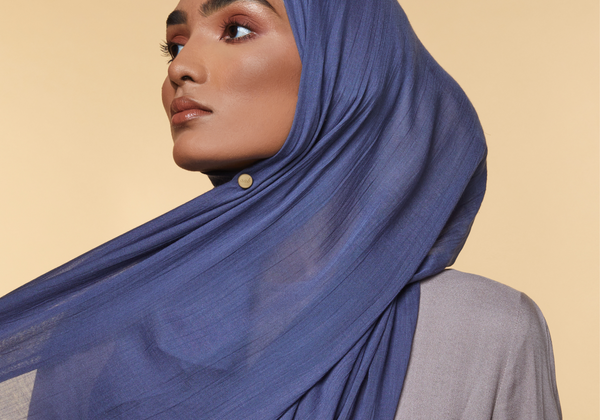For many Muslim women, wearing the hijab has become a part of our daily routine and often we may find that we’re wearing our hijabs more than we’re not. It’s important that something so integral to our daily lives is handled with proper consideration and care to maximise your comfort and the health of your hair and scalp whilst wearing your hijab.
We have compiled a series of common issues that many Muslim women may face whilst wearing the hijab. We’ve detailed how to tackle these issues and which types of products and properties you should be looking for in your hijab care regimen to minimise these effects.
Hair Thinning or Damage
Traction Alopecia is one of the leading causes for hair loss/thinning that women may experience whilst wearing a hijab. Traction Alopecia happens when pressure is concentrated on the hair strands as a result of pulling, tightness on the head or frictional rubbing, which results in hair loss. Imagine the tightness or headache you may experience from wearing your hair in a tight, high ponytail every single day. Generally, the main signs of Traction Alopecia is thinning around the hairline or around the crown.
Despite it being a common side effect of wearing hijab, this can easily be avoided by considering the weight/fabric of the hijab and the tightness at which you tie your hair. Hair loss should not be considered a normal part of wearing a hijab - if you notice these signs it’s likely you’re doing something wrong and need to change something.
A secure base under your hijab is vital for keeping your hair and hijab in place but it’s advisable to refrain from using a hairband that will cause breakage to your hair and pull tightly on your hair. A preferable option are Silk Scrunchies - you can keep your hair tied up without experiencing tightness and headaches since scrunchies are always a more gentle option than a standard hairband, plus pure silk can help to minimise damage to the actual hair strands.
Chiffon Silk Hijabs are also an ideal option as silk is widely known to help improve the condition of your hair - another great option for women who are struggling with hair loss and want to minimise the effects of it happening. They also have lightweight properties that essentially make it feel like you're wearing nothing on your head, which is great if you’re trying to minimise the amount of tightness/pressure your hair strands are experiencing.

Dandruff/Sweating/Dry Scalp
If you’re experiencing dandruff, sweating under your hijab or a dry scalp, it might be best for you to move towards wearing hijabs made from 100% natural properties.
Our Aloe Vera Hijabs are a great option if you struggle with sweat build up or dandruff under your hijab as the fibres of the fabric work to repel moisture and feature anti-bacterial properties. Another natural hijab that is suitable are the Ecovero Hijabs. Its porous fabric means it’s ultra breathable and has cooling effects to minimise any heat getting trapped under your hijab.

Slippage
If you happen to be struggling with your hijab slipping or not staying in place after you’ve spent countless amounts of times in the morning trying to get it right - it may be down to not having the basics in check.
Ask yourself, are the materials you’re using very soft and prone to slipping? Are you using anything to hold your hijab at certain points, like under your chin or are you simply just wrapping it around your head? Are you using an undercap?

If you are finding yourself that you prefer to wear softer hijab fabrics like Chiffon Silk, Modal or Crepe, it’s advisable to wear an undercap and use hijab magnets to avoid your hijab slipping. Our undercaps are made from an ultra soft and breathable Premium Jersey material. We also know that not everyone is accustomed to wearing an undercap, hence why we have three different undercap options to choose from:
Bandana Undercap
Our Bandana Undercaps are designed to cover the front portion of your hair, where your hijab is more prone to slipping. It’s perfect for those who perhaps do not want their entire head/hair to be covered with an undercap under their hijab, allowing for more breathability and comfort.

Full Coverage Tube Undercap
Tube Undercaps provide full coverage under your hijab - perfect for those wearing sheer fabrics for their hijab and want all of their hair covered.

Criss Cross Undercap
Similar to our Tube Undercap, our Criss Cross Undercap also provides full coverage under your hijab. However, the design at the front of the head differs. If you’re looking to change up your hijab style, this undercap may be an option for you.

Alternatively, you can opt for a more robust fabric for your hijabs like the Premium Jersey Hijabs - this fabric holds its shape, still remains breathable and light and you can get away without any hijab magnets and undercaps if you prefer not to use these items.
Hot/Cold Weather - Thickness of Materials
Finally, it’s always good to have knowledge of which materials are suitable for which climates so you’re dressed appropriately for each season of the year. It’s quite simple to determine if a hijab is light or heavy by judging the weight and sheerness of the fabric. Some fabrics can also be doubled up to make them thicker and keep you warmer. Below we’ve listed out which hijabs from Aab are right for each season:
Hot Climates:
Chiffon Silk Hijabs, Cotton Hijabs, Ecovero Hijabs, Aloe Vera Hijabs
Cold Climates:
Premium Jersey Hijabs, Modal Hijabs, Aloe Vera Hijabs, Cotton Hijabs
 UK
UK EU
EU US
US